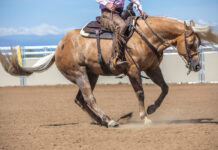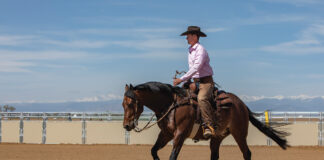Your body language speaks louder than words for your horse, so it’s important that you’re aware of what you’re saying.
If your horse is uninterested in you, use your entire body and anything you have in your hands to energize him. Remember to be as gentle as possible. Increase your body language in increments so you don’t overwhelm your horse.
“I’ll bring my knees up higher, use verbal cues—such as clucking—and start swinging the lead rope when I’m trying to bring some life into a situation,” says clinician Richard Winters, who wears chaps when he’s working with his horses to highlight his movement.
Maintaining Leadership:
Horses establish a herd hierarchy through different kinds of body language. If you throw a flake of hay to a couple of horses, it won’t take long to notice that the herd leader gets to eat first. It’s important that you are always the herd leader in your horse’s eyes.
“If your feet are going backward, your horse is probably training you,” Winters says. You shouldn’t simply back up or move out of the way when your horse walks toward you. He should yield to your space by moving backward.
Leading from the Saddle:
If you want your horse to go forward while mounted, bring some life to the situation by using some of the same techniques you used on the ground. “Bring your hands forward, squeeze with your legs and cluck,” explains Winters.
Your horse will feel that change in your body. If you want him to slow down, remember to soften your hands, sit deep and keep your body quiet.
Back to Go Bitless >>





